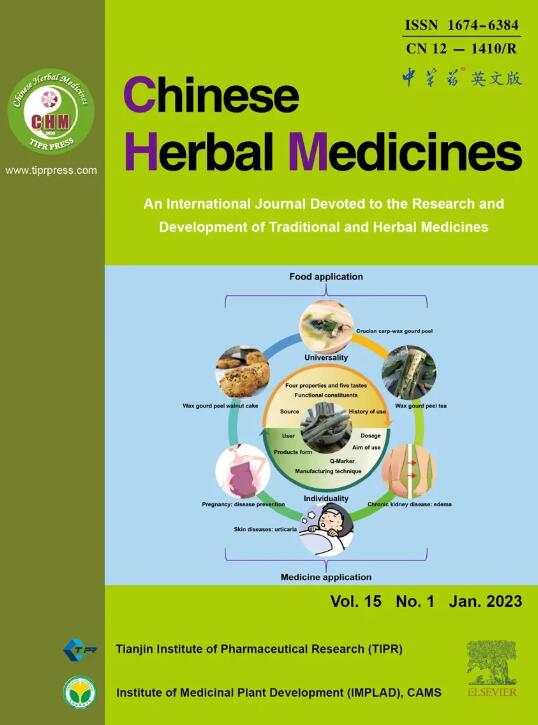山竹果提取物增强索拉非尼对HCT116和HepG2细胞的抗癌活性
IF 8.9
4区 医学
Q1 CHEMISTRY, MEDICINAL
引用次数: 0
摘要
目的:虽然高剂量的毒心苷常用于自杀或杀人,但正在进行的研究正在调查从蛇耳草果实中获得的低浓度提取物的潜在抗癌特性。本研究旨在确定泰国大黄果提取物与索拉非尼联合使用对HCT116和HepG2细胞的增强抗癌作用,并减少潜在的副作用。方法对鲜青果干粉进行分馏,定量测定其总苷、酚类、黄酮类、三萜等植物化学成分的含量。使用MTT法评估这些组分对HCT116和HepG2细胞的细胞毒性作用。在HCT116和HepG2细胞中表现出最显著反应的部分随后与索拉非尼联合观察其协同作用。然后评估细胞凋亡诱导、细胞周期进展和线粒体膜电位(MMP)。通过分析活性氧(ROS)的产生和抗氧化蛋白的表达水平,进一步探讨了凋亡效应的潜在机制。结果植物化学分析表明,大黄草乙酸乙酯部位(COEtOAc)含有丰富的心苷、酚类物质和类黄酮,二氯甲烷部位(CODCM)含有高含量的三萜和皂苷。处理24 h后,HCT116对COEtOAc的反应最为显著,HepG2对CODCM的IC50值分别为(42.04±16.94)μg/mL和(123.75±14.21)μg/mL。因此,COEtOAc (20 μg/mL)或CODCM (30 μg/mL)均以低于ic50浓度给药,与HCT116细胞(6 μmol/L)和HepG2细胞(2 μmol/L)的索拉非尼联合孵育24小时。这种联合对细胞活力的抑制作用约为50%。与单独治疗相比,联合治疗显著增强了细胞凋亡,减少了MMP,并引发了G0/G1期细胞周期阻滞。同时,ROS的形成增加,抗氧化酶超氧化物歧化酶2和过氧化氢酶的表达降低,支持了联合处理诱导细胞凋亡的机制。重要的是,HFF-1细胞的IC50值比癌细胞高2-3倍,证明了其抗癌作用具有良好的安全性。结论使用低于ic50浓度的COEtOAc或CODCM联合索拉非尼治疗可提高靶向抗癌效果,同时减轻副作用。未来的研究将集中在提取和表征活性成分,特别是心脏苷,以提高从有毒植物中提取的抗癌化合物的治疗潜力。本文章由计算机程序翻译,如有差异,请以英文原文为准。
Cerbera odollam fruit extracts enhance anti-cancer activity of sorafenib in HCT116 and HepG2 cells
Objective
While higher therapeutic doses of toxic cardiac glycosides derived from Cerbera odollam are frequently employed in cases of suicide or homicide, ongoing research is investigating the potential anticancer properties of low-concentration extracts obtained from the fruits of C. odollam. The present study aimed to determine the enhanced anticancer effects and minimize potential side effects of combining extracts from C. odollam fruits from Thailand with sorafenib against HCT116 and HepG2 cells.
Methods
The dried powder of fresh green fruits of C. odollam was fractionated, and its phytochemical contents, including total cardiac glycosides, phenolics, flavonoids, and triterpenoids, were quantified. The cytotoxic effects of these fractions were evaluated against HCT116 and HepG2 cells using the MTT assay. The fractions showing the most significant response in HCT116 and HepG2 cells were subsequently combined with sorafenib to examine their synergistic effects. Apoptosis induction, cell cycle progression, and mitochondrial membrane potential (MMP) were then assessed. The underlying mechanism of the apoptotic effect was further investigated by analyzing reactive oxygen species (ROS) generation and the expression levels of antioxidant proteins.
Results
Phytochemical analysis showed that C. odollam-ethyl acetate fraction (COEtOAc) was rich in cardiac glycosides, phenolics, and flavonoids, while the dichloromethane fraction (CODCM) contained high levels of triterpenoids and saponins. Following 24 h treatment, HCT116 showed the most significant response to COEtOAc, while HepG2 responded well to CODCM with IC50 values of (42.04 ± 16.94) μg/mL and (123.75 ± 14.21) μg/mL, respectively. Consequently, COEtOAc (20 μg/mL) or CODCM (30 μg/mL), both administered at sub-IC50 concentrations, were combined with sorafenib at 6 μmol/L for HCT116 cells and 2 μmol/L for HepG2 cells, incubated for 24 h. This combination resulted in a significant suppression in cell viability by approximately 50%. The combination of treatments markedly enhanced apoptosis, diminished MMP, and triggered G0/G1 phase cell cycle arrest compared to the effects of each treatment administered individually. Concurrently, increased formation of ROS and decreased expression of the antioxidant enzymes superoxide dismutase 2 and catalase supported the proposed mechanism of apoptosis induction by the combination treatment. Importantly, the anticancer effect demonstrated a specific targeted action with a favorable safety profile, as evidenced by HFF-1 cells displaying IC50 values 2–3 times higher than those of the cancer cells.
Conclusion
Utilizing sub-IC50 concentrations of COEtOAc or CODCM in combination with sorafenib can enhance targeted anticancer effects beyond those achieved with single-agent treatments, while mitigating opposing side effects. Future research will focus on extracting and characterizing active constituents, especially cardiac glycosides, to enhance the therapeutic potential of anticancer compounds derived from toxic plants.
求助全文
通过发布文献求助,成功后即可免费获取论文全文。
去求助
来源期刊

Chinese Herbal Medicines
CHEMISTRY, MEDICINAL-
CiteScore
4.40
自引率
5.30%
发文量
629
审稿时长
10 weeks
期刊介绍:
Chinese Herbal Medicines is intended to disseminate the latest developments and research progress in traditional and herbal medical sciences to researchers, practitioners, academics and administrators worldwide in the field of traditional and herbal medicines. The journal's international coverage ensures that research and progress from all regions of the world are widely included.
CHM is a core journal of Chinese science and technology. The journal entered into the ESCI database in 2017, and then was included in PMC, Scopus and other important international search systems. In 2019, CHM was successfully selected for the “China Science and Technology Journal Excellence Action Plan” project, which has markedly improved its international influence and industry popularity. CHM obtained the first impact factor of 3.8 in Journal Citation Reports (JCR) in 2023.
 求助内容:
求助内容: 应助结果提醒方式:
应助结果提醒方式:


